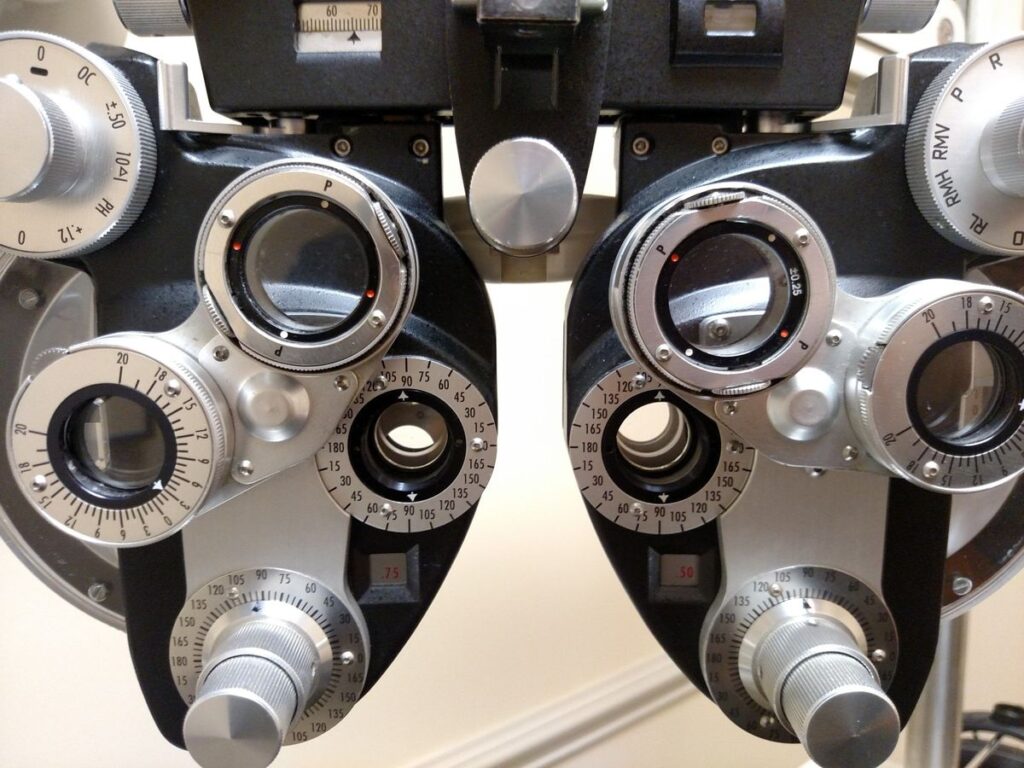The optometry industry is undergoing a significant transformation, driven by the advent of digital technologies. From virtual opticians to AI-powered prescription services, the landscape of eye care is evolving at a rapid pace. This article delves into the various facets of digital transformation in optometry, exploring how innovations are reshaping eyewear dispensing, enhancing patient care, and creating new opportunities for education and professional development. As we navigate the future of optometry, it’s essential to understand the impact of these changes and the ways in which professionals can adapt to stay ahead.
Key Takeaways
- Digital transformation is revolutionizing eyewear dispensing with real-time inventory systems and the emergence of virtual opticians.
- Artificial Intelligence is playing a pivotal role in optometry by building knowledge databases and offering personalized prescription recommendations.
- The human connection remains crucial, with technology being used to enhance remote engagement and create a sense of community.
- Digital marketing strategies, including social media engagement and digital branding, are becoming essential for optometrists to attract and retain patients.
- Ongoing education and staying informed about industry trends are key for optometry professionals to adapt and thrive in the digitally transformed future.
The Digital Revolution in Eyewear Dispensing

Real-time Inventory Systems
The advent of real-time inventory systems has revolutionized the way optometry practices manage their eyewear stock. By leveraging technology, these systems provide accurate and up-to-date information on inventory levels, enabling practices to make informed decisions about restocking and sales strategies. This contrasts sharply with traditional methods that often relied on memory or instinct, which are less precise and can lead to overstocking or stockouts.
Real-time inventory systems are not just about keeping track of what’s in stock; they’re about optimizing inventory decisions to maintain a competitive edge.
With the integration of devices like Topcon, Framedata, and Marco, data import into examination forms has become more efficient, ensuring that inventory reflects the latest sales and prescriptions. The table below illustrates the benefits of implementing such systems:
As the digital landscape continues to evolve, it is imperative for optometry practices to embrace these modern tools for sustained success.
The Rise of Virtual Opticians
The advent of virtual opticians marks a significant shift in the optometry landscape. Customers now have access to professional advice and eyewear fitting without leaving their homes. This convenience is reshaping how optical products are marketed and sold, offering a blend of technology and personalized service.
- Virtual consultations allow for a broader reach, connecting opticians with clients who may not have easy access to traditional stores.
- Advanced software simulates eyewear fittings, ensuring a proper fit and style selection.
- The technology also supports remote prescription verification, enhancing the accuracy of online eyeglass orders.
The integration of virtual opticians into the eyewear industry not only streamlines the process but also opens up new opportunities for customer engagement and service innovation.
As this technology continues to evolve, it will be crucial for opticians to adapt and embrace these digital tools to stay competitive. The potential for growth and improved customer satisfaction is immense, with virtual opticians poised to become an integral part of the optometry experience.
Improving Online Eyeglass Quality Control
The digital transformation in optometry has brought about significant advancements in how eyeglasses are dispensed and controlled for quality. Online platforms now enable more rigorous quality control processes, ensuring that customers receive eyewear that meets high standards of precision and durability. This is particularly important as the demand for online eyeglass purchases continues to rise.
Key metrics have become essential in monitoring and enhancing the quality of eyeglasses sold online. These metrics not only track the accuracy of prescriptions filled but also assess the physical quality of the eyewear. Here’s a brief overview of the metrics used:
By leveraging technology, optometry businesses can now offer a Tele-Optometry Platform that expands reach and ensures quality control without the need for the doctor to be physically present. This innovation is particularly beneficial for remote areas and for individuals who have difficulty visiting a clinic in person.
The integration of advanced quality control systems into online eyewear platforms is transforming the industry, setting new benchmarks for product excellence and customer satisfaction.
As the industry evolves, it is crucial to maintain a balance between technological efficiency and the assurance of quality. The future of online eyeglass quality control looks promising, with continuous improvements driven by customer feedback and technological advancements.
Artificial Intelligence: A New Vision for Optometry

AI in Building Knowledge Databases
The integration of Artificial Intelligence (AI) in optometry is revolutionizing the way knowledge databases are built and utilized. AI systems are capable of aggregating vast amounts of data from diverse sources, including clinical studies, patient records, and new research findings. This consolidation aids in the creation of comprehensive databases that can be accessed and analyzed with unprecedented speed and accuracy.
- Data Pipeline: Streamlining the collection and flow of information.
- Data Warehouse: Centralizing data storage for easy retrieval.
- Natural Language Processing (NLP): Enabling the interpretation of complex medical texts.
- Large Language Models: Providing insights by analyzing patterns in data.
The future of AI in the optics market is not just about data management; it’s about transforming the role of optometrists into one that is more informed and predictive. The potential for AI to enhance visual health through innovative applications is immense, sparking debates on how it will shape the profession.
By leveraging AI, optometrists can gain a deeper understanding of patient needs and tailor their services accordingly. The technology also opens up new avenues for industry collaboration and opportunities, ensuring that the field of optometry remains at the forefront of healthcare innovation.
Personalized Prescription Recommendations
The advent of AI-driven personalized treatment recommendations is a game-changer in optometry. By leveraging patient data and machine learning algorithms, optometrists can now provide highly accurate prescriptions tailored to individual needs. This not only enhances the patient experience but also improves diagnostic accuracy and workflow efficiency.
- Enhanced Patient Experience: Patients receive prescriptions that are fine-tuned to their visual requirements, leading to better outcomes and satisfaction.
- Diagnostic Accuracy: AI algorithms analyze vast amounts of data to identify patterns and predict the best corrective measures.
- Workflow Efficiency: Automation of prescription processes reduces manual errors and saves time for both patients and practitioners.
The integration of digital optometry tools with AI technology ensures that every patient receives the best possible care, with a focus on precision and personalization.
AI-Driven Virtual Fittings and Safety Eyewear
The integration of AI-driven virtual fittings is transforming the way we approach safety eyewear. With the ability to simulate various scenarios, opticians can now ensure that the prescribed safety eyewear not only fits perfectly but also meets the specific needs of the wearer’s environment. This technological advancement is crucial for industries where precise vision and eye protection are paramount.
The Future of Virtual Try-On Technology for Eyewear Shopping is not just a concept; it’s a reality that’s making eyewear shopping easier and more efficient. By narrowing down favorites before visiting a store or purchasing online, customers save time and make more informed decisions.
The benefits of AI in virtual fittings extend beyond convenience. Metrics such as frame fit, lens thickness, and field of vision can be analyzed to provide a tailored experience. Here’s a quick look at the impact of AI on safety eyewear:
- Automated interconnected facts drive efficient prescription safety eyewear.
- Independent community revolutionizes glasses industry through technology.
- Quality counts in product and prescription recommendations.
As we continue to embrace these innovations, the role of opticians evolves, blending the art of personal care with the precision of technology.
The Human Connection: Blending Technology with Personalized Care

The Role of Opticians in Remote Engagement
In the realm of optometry, the integration of remote engagement has revolutionized the way opticians interact with patients. Remote engagement tools allow opticians to extend their reach beyond the confines of a traditional office setting, providing care and consultation to patients wherever they may be. This shift towards remote work is not only a response to modern demands but also a proactive approach to expanding access to eye care services.
Opticians are now leveraging technology to perform tasks that were once thought to be strictly in-person. For example, the optometrist can remotely operate equipment such as the phoropter and chart, making it possible to adjust prescriptions or conduct examinations from a distance. This capability is particularly beneficial for patients with mobility issues or those in remote locations.
The adoption of remote engagement practices is a testament to the resilience and adaptability of the optometry profession. It underscores the commitment to patient care, regardless of physical barriers.
The table below outlines some of the key benefits of remote engagement for opticians:
As the industry continues to evolve, it is clear that the role of the optician will remain central to the delivery of eye care. By embracing remote engagement, opticians are not only adapting to the digital age but also reinforcing the human connection that is so vital to their profession.
Embracing Remote Work in Optometry
The optometry industry is increasingly recognizing the benefits of remote work, not just for opticians but for the entire eyecare team. Remote staffing solutions are emerging as a way to handle tasks such as ordering, paperwork, and patient engagement, without the need for a physical presence in the office.
- Remote work allows for a more flexible schedule, which can lead to increased job satisfaction and work-life balance.
- It opens up opportunities for talent across the country, not limited by geographical constraints.
- Utilizing remote opticians can help reduce dispensary chaos and streamline operations.
Embracing remote work in optometry can lead to a more efficient and satisfied workforce, while still maintaining the high standards of patient care.
Innovative software solutions, like Specsfax, are transforming traditional processes by converting faxed orders into digital ones, seamlessly integrating with lab management systems. This automation is crucial for ensuring that prescription safety eyewear is delivered accurately and efficiently. As the industry moves forward, the adoption of remote work practices will likely become a standard, benefiting both optometry professionals and patients alike.
Creating Community Through Technology
In the realm of optometry, technology has not only revolutionized treatment and services but also the way practitioners build and nurture their communities. The digital landscape offers a unique platform for optometrists to connect with their patients and peers, fostering a sense of belonging and support.
Optometry practices are increasingly leveraging online platforms to create forums, webinars, and social media groups that allow for continuous learning and interaction. These digital communities serve as a nexus for sharing knowledge, discussing challenges, and celebrating successes within the field.
- Forums and Discussion Boards: Encourage peer-to-peer support and knowledge exchange.
- Webinars and Online Events: Provide ongoing education and engagement opportunities.
- Social Media Groups: Offer a space for real-time communication and community building.
Embracing digital tools to create a sense of community not only enhances the patient experience but also empowers professionals to stay connected and informed in an ever-evolving industry.
Marketing and Branding in the Age of Digital Transformation

Digital Branding for Eye Care Professionals
In the realm of optometry, digital branding is more than just a buzzword; it’s a strategic imperative. Eye care professionals (ECPs) are recognizing the need to establish a strong digital identity to enhance their visibility and profitability in a competitive market.
The journey towards effective digital branding involves several key steps:
- Identifying the unique value proposition of the practice
- Crafting a compelling brand narrative
- Leveraging digital channels for outreach
- Engaging with the community through meaningful content
Embracing digital branding is not just about being seen; it’s about creating a connection that resonates with patients and distinguishes your practice.
Optometrists who overlook the power of platforms like LinkedIn may find themselves at a disadvantage when it comes to appointment bookings. A vibrant online presence, supported by digital marketing expertise, can lead to a more robust patient base and a thriving practice.
Leveraging Social Media for Patient Engagement
In the realm of optometry, social media has emerged as a pivotal platform for engaging with patients and fostering a sense of community. Optometrists can enhance their digital presence and connect with a broader audience by leveraging various social media channels. Tailoring content to specific demographics and health concerns can lead to more effective communication and patient education.
- Scheduled messaging and email campaigns allow for consistent patient outreach.
- AI-generated content and promotional templates provide a personalized touch.
- Analytics from social media interactions can inform targeted marketing strategies.
By integrating social media into their marketing strategies, eye care professionals can not only increase their outreach but also streamline their marketing efforts, leading to higher patient satisfaction and appointment rates.
The table below illustrates the impact of a well-executed social media strategy on patient engagement:
It’s clear that social media is not just a tool for marketing, but a means to connect and create lasting relationships with patients, ultimately contributing to the growth and success of optometry practices.
The Impact of Digital Outreach on Appointment Booking
The integration of digital outreach strategies has significantly streamlined the appointment booking process for optometry practices. Optical stores are integrating digital tools to enhance the patient experience, from initial contact to follow-up care. With the advent of telehealth services, patients are now able to access specialized eye care with greater ease, expanding the reach of optometrists beyond traditional boundaries.
Digital platforms have become a central hub for managing patient interactions. Features such as automated appointment reminders, online payments, and AI-based electronic health records (EHR) not only improve efficiency but also foster a more personalized approach to patient care. High patient satisfaction rates are a testament to the effectiveness of these digital solutions, with patients appreciating the speed and convenience of securing appointments.
The seamless integration of digital tools in optometry is reshaping the way appointments are booked and managed, offering a more efficient and patient-centric experience.
To illustrate the impact of digital outreach, consider the following data:
As optometry practices continue to embrace digital transformation, the role of digital outreach in appointment booking will only grow in significance, shaping the future of patient engagement and care delivery.
Looking Ahead: Education and Trends Shaping the Future of Optometry

The Importance of Education in Myopia Management
The escalating prevalence of myopia globally necessitates a robust educational approach for both optometrists and patients. Effective myopia management is contingent on comprehensive education that encompasses the latest research, treatment modalities, and patient communication strategies.
- Awareness and understanding of myopia risks and progression
- Treatment options such as orthokeratology, atropine drops, and multifocal contact lenses
- Lifestyle changes including outdoor activities and screen time management
- Parental involvement in recognizing early signs and adhering to treatment plans
Education in myopia management extends beyond the clinic. It involves creating a dialogue with the community to emphasize the importance of early detection and intervention. Optometrists play a crucial role in disseminating information and guiding patients through personalized treatment plans.
With the advent of platforms like EssilorLuxottica’s Leonardo and discussions at events like 100% Optical, professionals are equipped with the tools and knowledge to tackle myopia more effectively. The insights shared by experts in the field highlight the need for a collaborative approach to education, ensuring that optometrists stay at the forefront of myopia management.
2025 Eyewear Trends and Industry Predictions
As we approach 2025, the eyewear industry is poised to embrace a wave of new trends, heavily influenced by technological advancements and consumer preferences. Sustainability has transitioned from a niche concern to a central design philosophy, shaping the creation of new products. Brands like Bird Eyewear are leading conversations about eco-friendly practices, signaling a future where green initiatives are standard.
The rise of digital tools has also paved the way for innovative eyewear designs and personalized experiences. The launch of Good Karma Eyewear’s men’s collection at 100% Optical 2023 exemplifies the industry’s shift towards catering to diverse consumer needs with style and substance.
The integration of AI technology, as seen with Optos’s advancements in retinal imaging, suggests that future eyewear will not only be about aesthetics but also about enhancing health and vision capabilities.
Looking ahead, we can anticipate the following industry shifts:
- A focus on sustainable materials and production methods
- Increased personalization of eyewear through AI and digital fittings
- Greater emphasis on the intersection of fashion and function
- Expansion of myopia management solutions as demand grows
These trends are not just predictions; they are already taking shape, as evidenced by the discussions at 100% Optical events. The eyewear industry is on the cusp of a transformative era, where innovation meets individual needs and environmental responsibility.
Standardization and Professional Development in Optometry
The optometry field is witnessing a significant shift towards standardization and professional development. Online optometry platforms revolutionize eye care by improving efficiency, personalized treatment, and access to advanced tools. Optometrists adapt through continuous education, digital tools, and teleoptometry for underserved communities.
Professional development in optometry encompasses a broad spectrum of activities, from active CPD exams to practice team training and access to an extensive education library. The commitment to lifelong learning is crucial for staying abreast of the latest research, technology, and clinical practices.
The pursuit of excellence in optometry is not just about acquiring knowledge; it’s about applying that knowledge to enhance patient care and community health.
Standardization across the industry is essential for maintaining quality of care. This includes uniformity in training requirements, clinical procedures, and the use of equipment and supplies. The future of optometry relies on a foundation of well-defined standards that support both the professionals and the patients they serve.
As we peer into the future of eye care, it’s clear that education and emerging trends will play pivotal roles in shaping the field of optometry. From technological advancements to new patient care protocols, staying informed is key to staying ahead. To ensure you’re at the forefront of these developments, visit our website and explore a wealth of resources designed to keep you enlightened and equipped for the future. Dive into the latest insights and join the conversation today.
Conclusion
As we navigate the future of optometry, it’s clear that digital transformation is not just a trend but a pivotal shift in the industry. Innovations such as real-time inventory systems, virtual fittings, and AI-driven databases are revolutionizing the way optical products are marketed, sold, and dispensed. The insights from industry leaders like Charlene Nichols and Jennifer Gill underscore the importance of embracing technology, fostering a customer-centric approach, and seizing collaborative opportunities. The rise of virtual opticians and the integration of fashion and medicine through optical art highlight the diverse potential of this transformation. As we’ve seen with successful events like the optical metaverse gathering, the industry is ripe for reinvention. By leveraging digital tools and platforms, opticians and optometrists can enhance the quality of care, streamline workflows, and tap into new revenue streams. The future of optometry is bright, and those who adapt to these changes will lead the way in providing exceptional patient care and driving the industry forward.
Frequently Asked Questions
How is digital transformation impacting inventory management in optometry?
Digital transformation introduces real-time inventory systems that allow optometrists and eyewear retailers to manage stock levels more efficiently, reduce overhead costs, and respond quickly to consumer demand changes.
What role do virtual opticians play in the future of optometry?
Virtual opticians are emerging as a significant trend, offering remote consultations and virtual fittings through platforms like Zoom, which expands access to eyecare and personalizes the shopping experience for eyewear.
In what ways is AI being utilized to improve optometry services?
AI is being used to build knowledge databases for opticians, provide personalized prescription recommendations, and enable AI-driven virtual fittings and safety eyewear, enhancing the accuracy and customization of optometry services.
How can optometrists and opticians maintain a human connection with patients amidst increasing digitalization?
Optometrists and opticians can maintain a human connection by blending technology with personalized care, such as through remote engagement tools and community-building technologies that foster closer relationships with patients.
Why is digital branding important for eye care professionals?
Digital branding helps eye care professionals establish a strong online presence, connect with patients, and leverage digital channels like social media for engagement, ultimately impacting appointment bookings and practice growth.
What are some key trends and predictions for the eyewear industry looking forward to 2025?
Key trends include the integration of fashion and technology in eyewear, increased automation in optometry practices, and a focus on myopia management education. Predictions for 2025 also suggest a rise in the use of digital tools and virtual services.

I am a seasoned software engineer with over two decades of experience and a deep-rooted background in the optical industry, thanks to a family business. Driven by a passion for developing impactful software solutions, I pride myself on being a dedicated problem solver who strives to transform challenges into opportunities for innovation.
